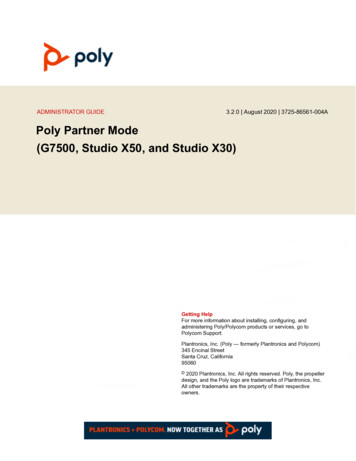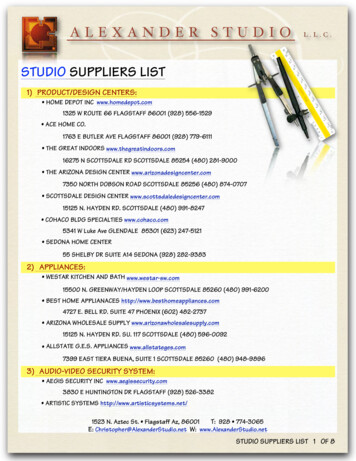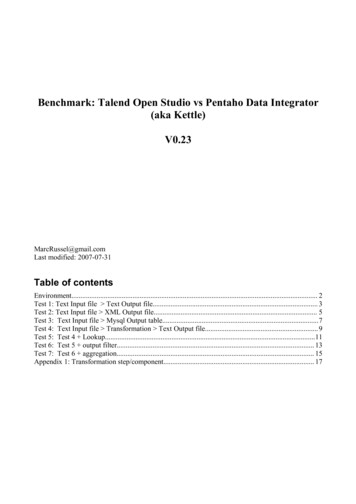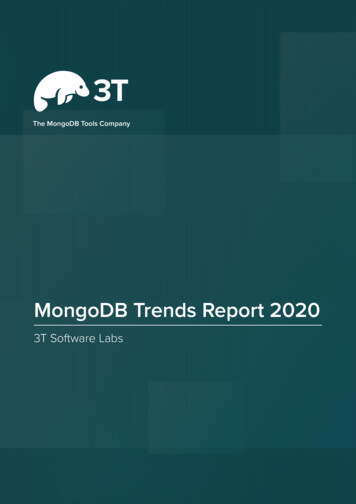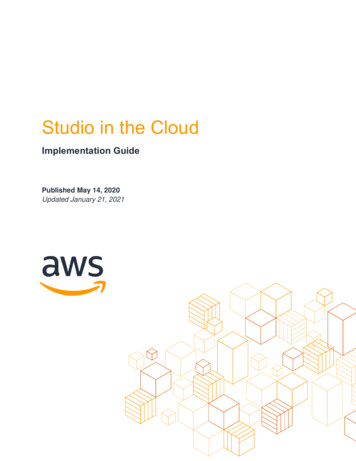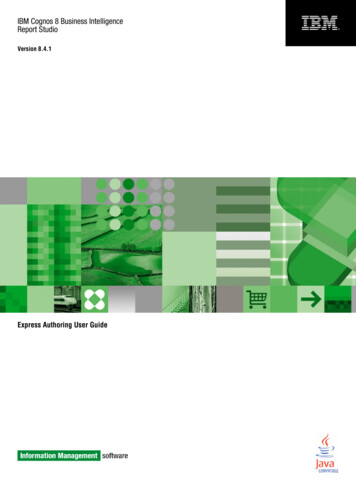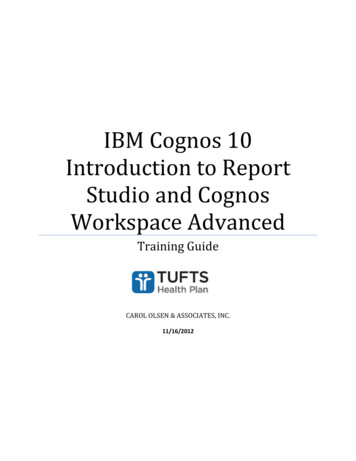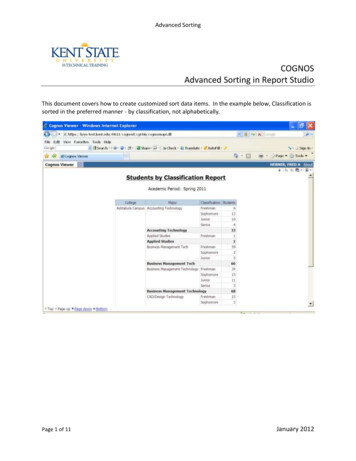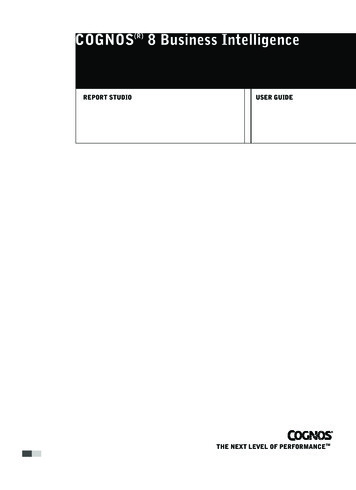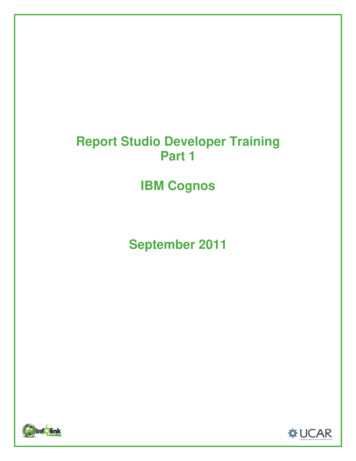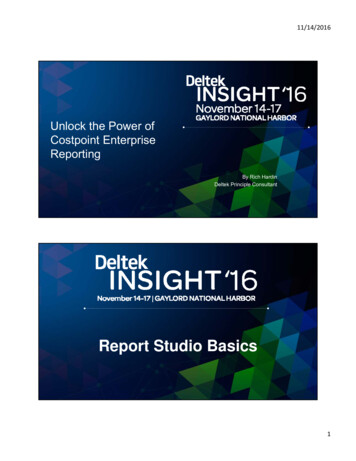
Transcription
Micro Focus VisualCOBOL 5.0 for VisualStudioRelease Notes
Micro FocusThe Lawn22-30 Old Bath RoadNewbury, Berkshire RG14 1QNUKhttp://www.microfocus.com Copyright 2020 Micro Focus or one of its affiliates.MICRO FOCUS, the Micro Focus logo and Visual COBOL are trademarks or registeredtrademarks of Micro Focus or one of its affiliates.All other marks are the property of their respective owners.2020-05-13ii
ContentsMicro Focus Visual COBOL 5.0 for Visual Studio Release Notes .4What's New . 5.NET Core Support . 5COBOL Formatting . 5Code Analysis . 5Enterprise Server Common Web Administration. 6COBOL Language Enhancements .6Compiler Directives . 7Consolidated Trace Facility (CTF) . 7Data File Tools . 7Database Access . 7Database Connectors . 8Debugging .8Enterprise Server Security . 8Micro Focus Unit Testing Framework . 9Platform Support . 10Product Documentation .10Visual Studio Integration . 10Significant Changes in Behavior or Usage .12Known Issues . 15Resolved Issues . 16Other Issues Resolved in This Release . 38Unsupported Functionality .40Installation . 41Before Installing . 41Downloading the Product . 41On Windows . 41Basic Installation . 44Installing . 45Advanced Installation Tasks . 45On Windows . 45After Installing . 47On Windows . 47Licensing Information. 51To activate Visual COBOL Personal Edition .51To request and activate a 30-day trial license for Visual COBOL .52To buy and activate a full unlimited license . 53To start Micro Focus License Administration.53Installing licenses . 53If you have a license file . 53If you have an authorization code .54To obtain more licenses . 54Updates and SupportLine.55Further Information and Product Support . 55Information We Need . 55Creating Debug Files . 56Copyright and Disclaimer. 57Contents 3
Micro Focus Visual COBOL 5.0 for VisualStudio Release NotesThese release notes contain information that might not appear in the Help. Read them in their entiretybefore you install the product.Note: This document contains a number of links to external Web sites. Micro Focus cannot beresponsible for the contents of the Web site or for the contents of any site to which it might link.Web sites by their nature can change very rapidly and although we try to keep our links up-to-date,we cannot guarantee that they will always work as expected.Check the Product Documentation section of the Micro Focus SupportLine Web site for anyupdates to the documentation which might have been uploaded.Product OverviewVisual COBOL enables you to develop COBOL applications within Microsoft Visual Studio. You use theVisual Studio integrated development environment (IDE) to edit, compile and debug COBOL applications.The IDE provides all the functionality to manage projects and build applications.The product is available in the following variants - Visual COBOL for Visual Studio 2017 and Visual COBOLfor Visual Studio 2019. The execution environment for applications created with any of these productvariants is COBOL Server.Upgrading from earlier Micro Focus productsThis version of your product is dependent on a later version of the Microsoft C run-time system than earlierMicro Focus products. This means that COBOL executables (.exe) built with a version earlier than 4.0might not be compatible with the current version of the run-time products. If the behavior of your applicationchanges with the current version, we strongly recommend that you relink the main executable with thecurrent version. This will ensure that the COBOL run-time system fully handles any run-time errorconditions that might occur.A new executable that is fully compatible with the current version can be produced without recompiling theapplication, as long as the original object code is available and it is relinked with the current version.To allow your executables to benefit from the product's latest programming and performanceenhancements, we recommend a full recompilation of your source code.If you are using Visual Studio, you can configure the IDE to automatically check whether applicationscreated with older releases must be relinked. If the application uses an older version of the C run-timesystem, Visual COBOL can automatically relink the existing executable or .dll to the new version of the Crun-time system without the need to recompile the application first. If a project needs relinking, VisualStudio displays a message in the status bar providing an option for you to choose and relink the project.4 Micro Focus Visual COBOL 5.0 for Visual Studio Release Notes
What's NewThis release provides enhancements in the following areas: .NET Core SupportCOBOL FormattingCode AnalysisEnterprise Server Common Web AdministrationCOBOL Language EnhancementsCompiler DirectivesConsolidated Trace FacilityData File ToolsDatabase AccessDatabase ConnectorsDebuggingEnterprise Server SecurityMicro Focus Unit Testing FrameworkPlatform SupportProduct DocumentationVisual Studio Integration.NET Core SupportBack to Top.NET Core is an open-source development platform that supports multiple operating systems. You can nowuse Visual COBOL to develop a COBOL application then publish it to be deployed on .NET Core.The following project templates for .NET Core applications are available - Class Library (.NET Core) andConsole App (.NET Core).COBOL FormattingBack to TopYou can now reformat your COBOL code in the editor according to your preference and standards.Formatting sets the indentation based on the configuration options which you can set in Tools Options Text Editor Micro Focus COBOL Formatting Indentation (for Visual Studio).You can find the COBOL formatting features on the Edit Advanced menu (for Visual Studio) menu.Code AnalysisBack to TopYou can now create the following views for your code: Program Flow Graph - enables you to view the overall structure of the COBOL program with nodesrepresenting sections and paragraphs. PERFORM statements between them which affect the programflow are represented by links joining the nodes. External calls to other programs are shown but cannotWhat's New 5
be expanded in the Program Flow Graph view. Hovering over the nodes shows a tooltip containing thecode representing the respective sections or paragraph. Clicking a node or a link joining said nodespositions the code editor to that point in the source, allowing quick and easy navigation of the program.Data Flow Analysis Tree - enables you to select a data item and then either statically trace what mightchange its value or what other data items it might affect.Enterprise Server Common Web AdministrationBack to TopNote: This feature is in Early Adopter Product (EAP) release status.Visual COBOL now includes a new Enterprise Server Common Web Administration interface (ESCWA).ESCWA is a web user interface and server for modern administration, monitoring and control of EnterpriseServer. It offers improved usability that consolidates the different Enterprise Server user interfaces so thatnative and managed regions, and security stores can be managed in one place. Features include: Administering directory servers across multiple hosts.Monitoring and control of Enterprise Server instances.Configuring and administering a security store, defined in an LDAP-compatible security manager suchas Microsoft Active Directory or OpenLDAP.Administering the Scale-Out features - enable you to specify logical groups of Enterprise Serverinstances, and configure and run Performance Availability Clusters (PACs) and their related Scale-OutRepositories (SORs).Administering, monitoring and control of Enterprise Server for .NET regions and listeners.The use of current web frameworks that have a greater focus on security.(Included with 5.0 Patch Update 2 ) - support for Enterprise Server XA, MQ and PL/I configuration andmonitoring. This includes support for XA resources, configuring MQ, Listeners and Writers, PL/I, MFCSconsole, Region Trace options, displaying the current ESMs on logon page and Local/loopbackconnections warning changes.COBOL Language EnhancementsBack to TopThe following enhancements have been made to the COBOL syntax: ISO2002 conditional compilation - an additional mechanism for conditional compilation, the ISO2002Conditional Compilation method, is now available. This has been implemented as part of the support forEnterprise COBOL 6.2.The following compiler directing statements are supported: DEFINE IF/ ELSE/ END-IF 6 What's New EVALUATE/ WHEN/ WHEN OTHER/ END-EVALUATEThe JSON PARSE statement enables you to convert JSON text into COBOL data formats. This hasbeen implemented as part of the support for Enterprise COBOL 6.2.Async and await syntax (.NET COBOL only) - support is available for asynchronous programmingin .NET COBOL using the async and await syntax.INSPECT statement - the performance of INSPECT. CONVERTING has been improved, particularlyfor cases where source-alphabet is long.Support has been added for the portable syntax for SET - set[string].
Compiler DirectivesBack to TopThe following Compiler directives are new in this release:ILNORMALIZENAMES Determines the program elements that are normalized when a program iscompiled to .NET or JVM COBOL. Normalization in this context results inreplacing all and - (hyphen) characters with (underscore) characters in thename of the generated class file.Consolidated Trace Facility (CTF)Back to TopThis release provides the following enhancements: Dynamic CTF - it is now possible to configure the CTF dynamically from outside the process beingtraced.Using a new command line utility - cblctd - you can alter the tracing events of running applicationsthat already have CTF tracing enabled. You can alter trace levels, add or remove components to or fromthe trace, and also configure the emitters in effect.Additionally, there is also a new component that you can trace - mf.mfdbfh enables you to trace activityof the Micro Focus Native Database File Handler.Data File ToolsBack to TopThis release provides the following enhancements: The Data File Editor now includes a Compare Files tool that enables you to compare the contents oftwo data files side-by-side.Structure files, and the layouts within them, can now be created within the Data File Editor; you nolonger need to use the Classic Data File Tools utility to manage your layouts.When connecting to a VSAM dataset stored in an enterprise server region, you can store anypasswords required for access, for the duration of your current session.You can view archived JES spool jobs that have been merged into one spool file using the mergingarchived spool files process.You can now quickly duplicate records in non-indexed files, using the Duplicate Record option.Database AccessBack to TopEnhancements are available in the following areas:OpenESQL ADO.NET Connection Editor Toolbar A new "i" (information) button is available that provides all the details of any installed .NET provider.Provides additional information mitigating resource definition and use within the ADO.NET ConnectioneditorWhat's New 7
Static XA switch modules "Reconnect" - At the beginning of a global transaction, the XA switch willattempt to reconnect temporarily broken connections to the database. If there is a temporary disconnectto the database, there is no need to manually re-enable the XA switch to run transactions.Database ConnectorsBack to TopYou can now create an identity column in your database by using a new XFD directive IDENTITY COLUMN. This must be specified on a numeric field.DebuggingBack to TopThis release includes the following enhancements: COBOL Visualizer - a new window in Visual Studio enables you to view and edit a data item duringdebugging in either text or HEX forms. You invoke the window from the DataTip for the data item. Conditional watchpoints - you can now specify conditions and hit counts for COBOL watchpoints. Acondition can be in the form of an expression or it can be a hit count (for the number of times memoryassociated with a data item has been updated). The condition is evaluated each time the data itembeing watched changes. If the condition evaluates to true, then program execution stops. This enablesmore fine-tuning of the current watchpoint support and is useful when debugging large, complexprograms. Dynamic core dumps - you can now invoke a core dump programmatically and continue execution ofyour program. A new library routine, CBL CREATE CORE, enables you to produce a core file for thecurrent process or a process owned by the same user that owns the current process. Improved visibility of the PERFORM stack - the PERFORM stack and PERFORM range names arevisible in system debuggers such as gdb in many cases on 32-bit Linux with Intel architecture andSolaris with Intel architecture. This was already the case on AIX, 64-bit Solaris-Intel, and all other Linuxplatforms (including 64-bit Linux-Intel). In order to include source line numbers in run-time error messages, which makes the diagnosis ofissues in your program easier, the COBOL compiler now produces .idy files by default when buildingfrom the command line, unless the NOANIM directive is specified. You can safely remove .idy filesafter compilation if you do not need them; they do not need to be distributed with your application unlessyou want to debug your code. However, unless you specify the ANIM directive, generated executablessuch as .dll and .gnt will not be debuggable, which is consistent with prior behavior.Note: Behavior has not changed if you are using an IDE or build scripts generated by an IDE.Enterprise Server SecurityBack to TopThis release includes the following enhancements: 8 What's NewSecurity - security features can now be employed when developers and administrators install newCOBOL services (web services and EJBs) into an enterprise server instance over the network. Thereare a number of authentication and authorization options that can be enabled. See DeploymentListeners and The .mfdeploy File in your product Help.
Vault Facility - a new security feature has been added that enables some Enterprise Server componentsto keep certain sensitive information in a form of storage defined as a vault, accessible via aconfigurable vault provider. The default vault provider stores data in encrypted format on disk.OpenSSL 1.1.1 - the OpenSSL security provider has been updated to OpenSSL version 1.1.1.This is the stable Long Term Support version of OpenSSL. Added support for the ratified TLS protocol version 1.3. TLS 1.3 benefits include: Much shorter initial connection negotiation sequence. This reduces the time taken to establish alink before starting to transmit data. Using only the most secure ciphers and hash methods. TLS 1.3 will be negotiated in preference to the older TLS protocols. Added support for new Ciphers and Key Exchange groups in line with TLS 1.3 requirements. The default security level for previously configured endpoints has been moved from Security Level 0to Security Level 1. This removes the ability to accidentally make use of known-weak elements suchas SSL3 and MD5. Similar changes to the default Security Level have recently happened to Java,Chrome, Firefox, and other systems providing secure connections.Fileshare Security - the Fileshare Secure TCP/IP transport provider now supports the trusted use ofX509 certificates bearing the name of the Fileshare service as the Common Name element of thecertificate.In previous releases, a secure connection to a Fileshare server was made using a certificate thatrepresented the network location upon which the Fileshare service was located. This method is stillsupported, but does not dist
May 13, 2020 · Visual Studio integrated development environment (IDE) to edit, compile and debug COBOL applications. The IDE provides all the functionality to manage projects and build applications. The product is available in the following variants - Visual COBOL for Visual Studio 2017 and Visua
